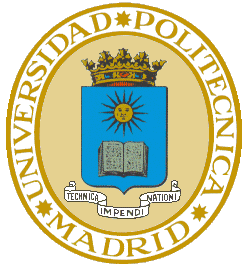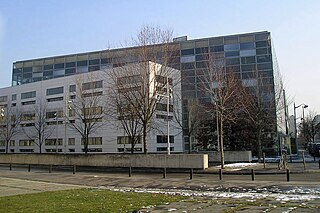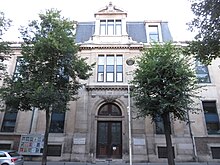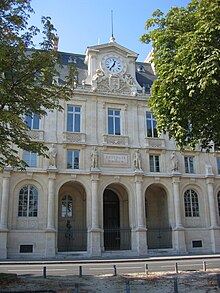
Nancy is the prefecture of the northeastern French department of Meurthe-et-Moselle. It was the capital of the Duchy of Lorraine, which was annexed by France under King Louis XV in 1766 and replaced by a province, with Nancy maintained as capital. Following its rise to prominence in the Age of Enlightenment, it was nicknamed the "capital of Eastern France" in the late 19th century. The metropolitan area of Nancy had a population of 511,257 inhabitants at the 2018 census, making it the 16th-largest functional urban area in France and Lorraine's largest. The population of the city of Nancy proper is 104,885.

A grande école is a specialized top-level educational institution in France and some other previous French colonies such as Morocco and Tunisia. Grandes écoles are part of an alternative educational system that operates alongside the mainstream French public university system, and take the shape of institutes dedicated to teaching, research and professional training in either pure natural and social sciences, or applied sciences such as engineering, architecture, business administration, or public policy and administration.

Mines Paris – PSL, officially École nationale supérieure des mines de Paris, is a French grande école and a constituent college of PSL Research University. It was originally established in 1783 by King Louis XVI.

The University of Toulouse is a community of universities and establishments (ComUE) based in Toulouse, France. Originally it was established in 1229, making it one of the earliest universities to emerge in Europe. Suppressed during the French Revolution in 1793, it was refounded in 1896 as part of the reorganization of higher education. It was finally abolished in 1969, giving birth to the three current universities: Toulouse 1 Capitole University, University of Toulouse-Jean Jaurès and Toulouse III - Paul Sabatier University. The ComUE in the Toulouse region was known as Federal University of Toulouse Midi-Pyrénées. On January 1, 2023, the university was renamed as the University of Toulouse.

The Technical University of Madrid or sometimes called Polytechnic University of Madrid is a public university, located in Madrid, Spain. It was founded in 1971 as the result of merging different Technical Schools of Engineering and Architecture, originating mainly in the 18th century. Over 35,000 students attend classes during the year.

Vandœuvre-lès-Nancy is a commune in the Meurthe-et-Moselle department in north-eastern France. Its inhabitants are called Vandopériens.

The Federal University of Itajubá, is a federal university located in the state of Minas Gerais, Brazil. It is considered the first technological university and one of top ten engineering schools in Brazil. Extremely reputable among Brazilian engineering schools, it carries more than 100 years of tradition in teaching, with emphasis on Electrical Engineering – which is one of the best research institutes on Power Systems field in Latin America – Mechanical Engineering, Environmental Engineering, Materials Engineering, Automation and Control engineering and Computer Engineering.

Nancy-Université was a French federal university which federated the three principal institutes of higher education in Nancy, Lorraine before their merger into the University of Lorraine:

Toulouse Institute of Technology is a French university cluster based in Toulouse, France, part of University of Toulouse. It was founded in 1969. The institute is composed of seven schools and 17 research laboratories. The institute delivers master's degrees and Ph.D. It is a member of Institut au service du spatial, de ses applications et technologies.

Paul Verlaine University – Metz was a French university, based in Metz. It merged with Nancy-I, Nancy-II, and the INPL forming the University of Lorraine. The merger process started in 2009 with the creation of a "pôles de recherche et d'enseignement supérieur" or PRES and was completed 1 January 2012.
National Polytechnic Institute of Lorraine is a French technological university system, based in Nancy. It is under the Academy of Nancy and Metz.

The Henri Poincaré University, or Nancy 1, nicknamed UHP, was a public research university located in Nancy, France. UHP formed the Nancy-Université federation with two other institutions in 2005. In 2012, Nancy-Université was merged with University Paul Verlaine of Metzinto to form the University of Lorraine.
French university associations known as "pôles de recherche et d'enseignement supérieur" were a form of higher-level organization for universities and other institutions established by French law in effect from 2007 to 2013. The 2013 Law on Higher Education and Research (France) discontinued the PRES; these have been largely replaced by the new Communities of Universities and Institutions. The list below indicates the status of those institutions designated as PRES or related associations before the 2013 law took effect. See the list of public universities in France for the current status of these institutions.

University of Upper Alsace is a multidisciplinary teaching and research centre based in the two cities of Mulhouse and Colmar, France. Research and teaching at UHA concentrates mainly on science, technology, economics, management, arts and humanities. In 2017, UHA has more than 8000 students with about a hundred courses offered. The founding of UHA was driven by social and business players, among them was Jean-Baptiste Donnet.

Institut Mines-Télécom (IMT) is a French public academic institution dedicated to Higher Education and Research for Innovation in the fields of engineering and digital technology, organized as a Collegiate University. Created in 1996, it was originally known as the "Groupe des écoles des télécommunications", or GET, followed by the "Institut Télécom". The Mines schools, which were placed under the administrative supervision of the Ministry of Industry, joined the Institut in March 2012 when it took on its current name and gained the status of Grand établissement. It combines high academic and scientific legitimacy with a practical proximity to business and a unique positioning in 3 major transformations of the 21st century: Digital Affairs, Energy and Ecology, and Industry. Its training and research for innovation are rolled out in the Mines and Télécom Graduate Schools. The Institut falls under the administrative aegis of the General Council for the Economy, Industry, Energy and Technologies.

The École nationale supérieure de l'énergie, l'eau et l'environnement(Ense3) is one of the engineering schools of the Institut National Polytechnique de Grenoble. As a grande école, students are admitted through a nationwide competitive examination. It was formed by the merger of the École nationale supérieure d'hydraulique et de mécanique de Grenoble (ENSHM) and the École nationale supérieure d'ingénieurs électriciens de Grenoble (ENSIEG).

CentraleSupélec (CS) is one of the most prestigious and selective grandes écoles in France and is a member of the graduate engineering school of Paris-Saclay University in Gif-sur-Yvette, France. It was established on 1 January 2015, as a result of a strategic merger between two prestigious grandes écoles in France, École Centrale Paris and Supélec. CentraleSupélec is also considered to be among the best engineering schools of France and most elite institutions in Europe, with an admission rate of 6 to 8% in 2019. It is one of the constituent members of Paris-Saclay University.

IMT Atlantique Bretagne Pays de la Loire is a technological university, which was created on January 1, 2017 through the merger of the École nationale supérieure des mines de Nantes and Télécom Bretagne. The engineering school is part of the Grandes Écoles, a prestigious group of French institutions dedicated to engineering, scientific research, and business education. It consists of three campuses: Brest, Nantes, Rennes. IMT Atlantique is a school of the Institut Mines-Télécom and a member of the Université Bretagne Loire.

École nationale d'ingénieurs de Metz is a French grande ecole of engineering established in 1960. It is one of the Groupe des écoles nationales d'ingénieurs, but also an internal school of the Collegium National Polytechnic Institute of Lorraine (INPL).

The École Européenne d'Ingénieurs en Génie des Matériaux (EEIGM) is a French engineering College created in 1991.























